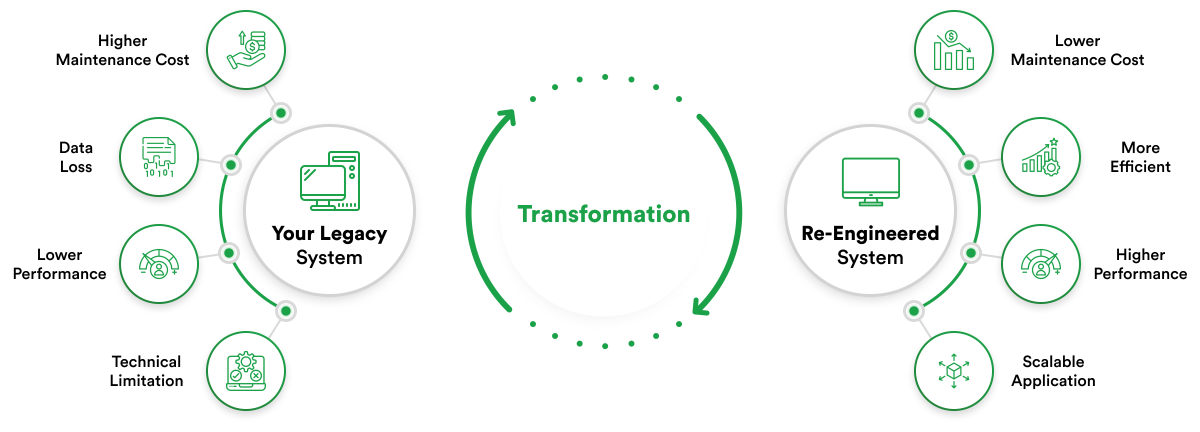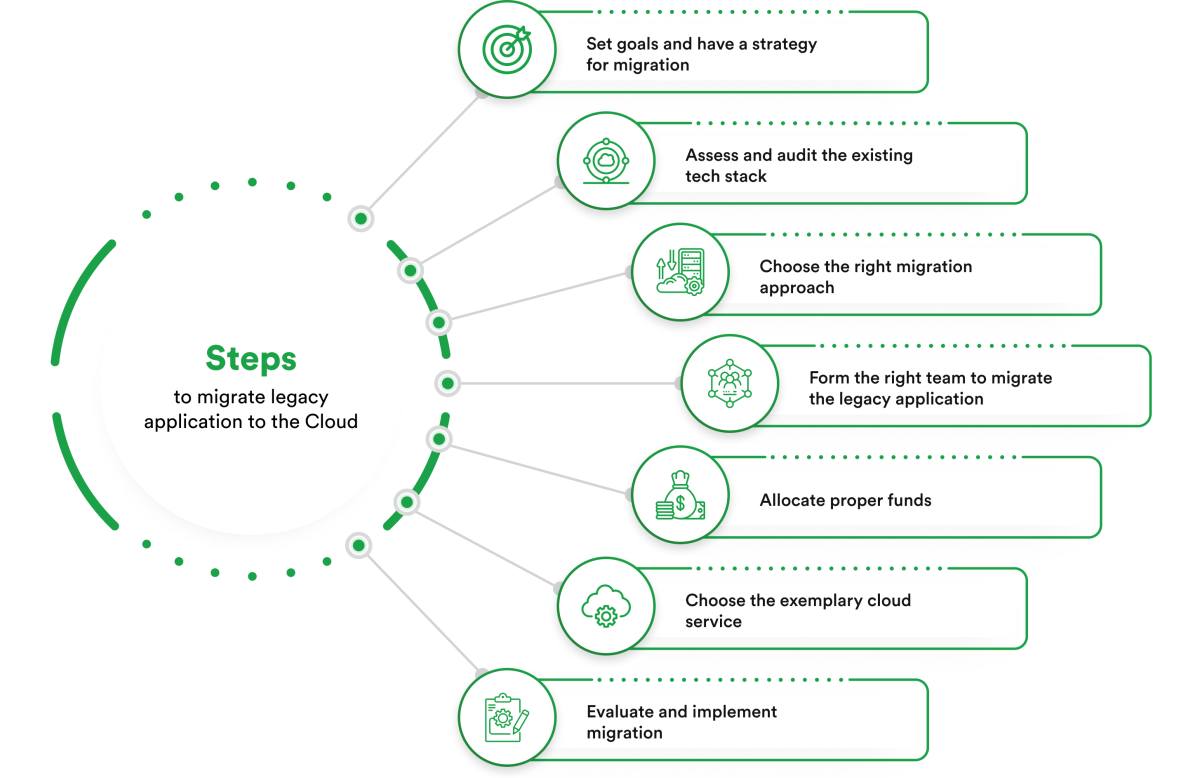
Navigating Cloud Migration: Overcoming Challenges and Maximizing Benefits
Exploring some of the key considerations and challenges in migrating legacy applications to the cloud and sharing practical strategies for a successful transition.
In the world of technology, legacy applications are often seen as obstacles to progress and innovation. These systems, built on older technologies, typically function in standalone environments, and need help to meet current demands for integration and scalability. A report by Allied Market Research projects that the global application modernization services market will grow from $15.5 billion in 2022 to $69.8 billion by 2032. This growth highlights a significant shift: businesses are increasingly transitioning their legacy systems to the cloud to capitalize on cost efficiency, improved performance, and enhanced scalability.
Migrating legacy applications to cloud infrastructure is not just a technical upgrade. It’s a strategic decision that complements broader digital transformation efforts seizing the banking, healthcare, and manufacturing industries. These sectors prioritize data security and compliance, and moving to the cloud offers a chance to revitalize old systems and introduce new features that enhance service delivery and operational efficiency.
This article offers organizations a comprehensive guide to navigating the complexities of transitioning legacy applications to cloud infrastructure. It outlines careful planning strategies, modernization techniques, and practical migration steps to help IT leaders manage a seamless transition.
Navigating the complexities of cloud migration starts with a well-thought-out strategic plan. This initial phase sets the stage for a successful move from outdated legacy systems to modern, flexible cloud solutions.
A thorough assessment is the first important step in planning a successful migration of legacy applications to the cloud. This phase involves conducting a SWOT analysis to systematically evaluate your legacy systems’ strengths, weaknesses, opportunities, and threats. Understanding the current IT environment is equally important. This includes mapping out all application dependencies and evaluating the scalability and security of existing systems. Such assessments help identify the key areas that will benefit from cloud capabilities and those that may pose challenges during the migration.
Defining clear, actionable goals for cloud migration is fundamental for guiding the effort and measuring success. Typical objectives include cost reduction, which remains a significant driver for cloud adoption. According to a survey by Flexera, 61% of companies reported cost savings as a primary reason for cloud migration. Other goals are to improve scalability to handle varying loads without compromising performance or enhancing business continuity capabilities. However, aligning these migration goals with the company’s overall strategic vision is the most critical aspect. This ensures that the move to the cloud supports long-term business growth and adaptability. All stakeholders must be on board with these goals to streamline department efforts.
Effective preparation for cloud migration entails a meticulous selection of the right cloud provider and the migration approach. It’s crucial to choose a provider whose cloud infrastructure services match your specific security, compliance, and performance needs. Similarly, deciding whether to lift-and-shift, re-platform, or refactor applications can significantly influence both the migration process and the outcome. Additionally, a detailed migration plan should be developed, including timelines, resource allocation, risk management strategies, and contingency plans to address potential setbacks.
Equipping your team with the necessary skills and knowledge to manage new cloud environments is essential. This may involve training sessions, workshops, or partnering with a cloud consultant for expert guidance. Ongoing support mechanisms, such as help desks or dedicated technical support teams, should be established to assist employees during and after the transition, ensuring they can effectively utilize cloud technologies.
The strategic decisions made during a cloud migration profoundly impact the initiative’s efficiency, cost, and overall success. Let’s explore the primary approaches for modernizing legacy applications and transitioning them to the cloud, focusing on the crucial choices between refactoring, rebuilding, re-platforming, and re-architecting.
Organizations have several options when it comes to modernizing legacy applications before migrating to the cloud.
Refactoring is modifying existing application code to enhance its functionality in the cloud, improving flexibility and scalability without a complete system overhaul.
On the other hand, completely rebuilding an application may be necessary for systems with outdated architectures that delay business growth. This approach allows for integrating modern technologies and practices from the ground up.
Re-platforming provides a compromise involving minimal changes to the code but adjustments to the platform that improve performance in a cloud environment.
Re-architecting, the most comprehensive approach, entails significant changes to the application architecture to leverage cloud-native features, such as microservices and containerization fully.
The appropriate migration strategy is critical for aligning IT capabilities with business strategies.
The ‘lift-and-shift‘ approach, also known as rehosting, involves transferring applications to the cloud without modifications, which can be faster and less costly. However, while lift-and-shift achieves quick results, it may need to fully optimize the applications to maximize the cloud’s cost-efficiency and scalability.
Alternative strategies include application rationalization, where each application is evaluated to determine whether it should be moved to the cloud, replaced, or retired. This strategic decision-making can significantly reduce IT costs and enhance operational efficiency.
Another viable option is application replacement, which involves substituting legacy applications with cloud-native solutions better suited to current and future business needs.

Migrating legacy applications to the cloud involves systematic steps that ensure a smooth and effective transition. By meticulously following each step, organizations can mitigate risks and maximize the benefits of cloud computing.
The first crucial step is to establish clear goals and formulate a comprehensive migration strategy. This sets the direction for the migration and provides a roadmap for success. According to a report by McKinsey, businesses that set specific, measurable goals for their cloud migration are 1.5 times more likely to achieve successful outcomes compared to those that do not. The strategy should address the scope, timeline, budget, and expected benefits of the migration, ensuring alignment with overall business objectives. This involves stakeholder engagement to secure support and facilitate a unified approach.
Conducting a thorough assessment and audit of the existing technology stack allows organizations to understand the complexity and readiness of their applications for cloud migration. This step involves evaluating current systems’ technical, operational, and financial aspects. An effective tech stack audit can help identify critical dependencies and potential migration issues, helping refine the strategy and approach.
The migration approach dramatically influences the success of the cloud transition. Each method offers different benefits and challenges, whether lift-and-shift, refactoring, re-platforming, or re-architecting. IDC reports that 63% of enterprises find choosing the correct migration approach a critical factor in achieving the efficiency and scalability benefits of the cloud. Deciding on the right approach depends on the organization’s specific needs, goals, and existing infrastructure.
Assembling a skilled migration team is more than just a task. It’s a critical part of the migration process. This team, which should include tech professionals with expertise in cloud computing, cybersecurity, project management, and change management, is the backbone of the migration. According to Forbes, companies that invest in cross-functional teams for cloud migration are more likely to complete their migration on time and within budget. This team is responsible for planning, executing, and migration process to ensure it meets the strategic business objectives.
Ensuring adequate funding for the migration project is essential for covering costs associated with new tools, technologies, and training. Businesses that allocate a specific budget for cloud migration are more likely to experience a smooth transition without unexpected financial overruns. Proper funding also helps address unforeseen challenges during the migration process.
Selecting the right cloud service provider is fundamental. This choice should be based on aligning the provider’s capabilities with the organization’s specific needs, such as compliance, scalability, and support services. According to a survey by KPMG, 80% of businesses report improved performance after choosing a cloud provider that aligns closely with their operational demands.
The final step is the actual implementation of the migration plan. This stage involves the careful execution of the chosen migration approach, continuous monitoring of the process, and making necessary adjustments. This iterative approach allows for refinement and optimization of the migration strategy, ensuring that the transition supports the organization’s long-term objectives.

Ensuring the success of a cloud migration project involves sticking to established best practices that guide actions from initial planning to final execution. These practices are distilled from the experiences of numerous organizations that have navigated the migration path before. By adopting these best practices, companies can avoid common traps and enhance their chances of a smooth and beneficial transition to the cloud.
Any cloud migration strategy must prioritize data backup and implement robust security measures. To address these concerns, it’s essential to ensure all data is backed up before migration begins. This secures data against loss and provides a recovery path if the migration encounters problems. Furthermore, integrating comprehensive security practices, such as encryption and multi-factor authentication, safeguards sensitive information during and after the transition to the cloud.
Conducting pilot tests of critical components of the migration plan can reveal potential issues in a controlled environment, reducing the risk of widespread impact on business operations. This approach allows IT teams to understand the behavior of applications in the cloud and make necessary adjustments before a full-scale rollout. Phased migration minimizes disruptions and helps build confidence in the migration process among stakeholders.
To fully benefit from cloud adoption, leveraging cloud-native features such as auto-scaling, containerization, and microservices architectures is essential. These features enable enhanced scalability and operational agility, vital for responding to changing market conditions and business needs. Adapting applications during the migration to fully use these features can transform business processes and drive innovation.
While migrating legacy applications to the cloud offers multiple benefits, it has its considerations and potential challenges. Awareness of these issues and planning accordingly helps organizations navigate the complexities of cloud migration more effectively and avoid common pitfalls that impede success.
One of the significant challenges in cloud migration is the risk of vendor lock-in, where switching cloud providers can become expensive and complex. To facilitate future transitions, if necessary, it is crucial to choose a cloud provider whose services meet current needs and offer flexibility and compatibility with other services. A thorough evaluation of the provider’s service level agreements (SLAs), support services, compliance standards, and roadmap for future technologies should inform this decision.
Cloud migration is often pursued for potential cost savings, but managing costs in the cloud can be challenging without proper planning and monitoring. To maximize the benefits of cloud adoption, it’s essential to prioritize cost optimization. This can be achieved through regular reviews of cloud spending, employing auto-scaling to adjust resources according to demand, and choosing the suitable pricing model for the services used. Leveraging reserved instances or savings plans for predictable workloads can significantly reduce costs.
Integrating legacy applications with modern, cloud-based services poses another challenge, primarily due to differences in technology stacks and architecture. However, this challenge can be met with a well-thought-out integration strategy that uses APIs or middleware solutions to ensure seamless communication between old and new systems. This reassurance can instill confidence in the audience about the feasibility and success of their cloud migration journey.
Migrating legacy applications to the cloud is much more than a mere technical update; it’s a strategic transformation pivotal to a business’s digital strategy. This journey promises significant benefits like cost efficiency, enhanced performance, and superior scalability, as highlighted by the growth forecast from $15.5 billion in 2022 to an expected $69.8 billion by 2032 in the application modernization services market.
As industries like banking, healthcare, and manufacturing increasingly adopt cloud solutions, they not only modernize aging infrastructures but also align with cutting-edge security and compliance standards. This shift is crucial for revitalizing old systems and integrating innovative features that advance service delivery and operational efficiency.
The comprehensive guide provided here details of strategic planning, modernization techniques, and practical migration steps essential for IT leaders to ensure a smooth and effective transition. By following these outlined practices, businesses can navigate the complexities of cloud migration successfully and with confidence.
Embracing cloud technology is not just about keeping up with technological advances—it’s about setting your business up for future success in a digitally-driven world. For those on their migration journey or looking to enhance their cloud setups, the insights and strategies shared here serve as a robust foundation for creating a resilient, efficient, and dynamic cloud environment.
Ready to elevate your business with cloud technology? Dive deeper into our strategies and insights to harness the full potential of the cloud and propel your business into a new era of digital excellence. Let’s embark on this transformative journey together and redefine what’s possible for your operations and services.

Exploring some of the key considerations and challenges in migrating legacy applications to the cloud and sharing practical strategies for a successful transition.

Delving into the essence of successfully implementing ML projects, exploring strategic approaches, the comprehensive life cycle from conception to deployment, and real-world industry applications.

This article explores five solid arguments for why companies should move their current CCTV system to the cloud and how it can create several advantages for their operations.
Copyright © 2023 rinf.tech. All Rights Reserved.
Terms & Conditions. Cookie Policy. Privacy Policy.
Politica Avertizari de Integritate (RO)